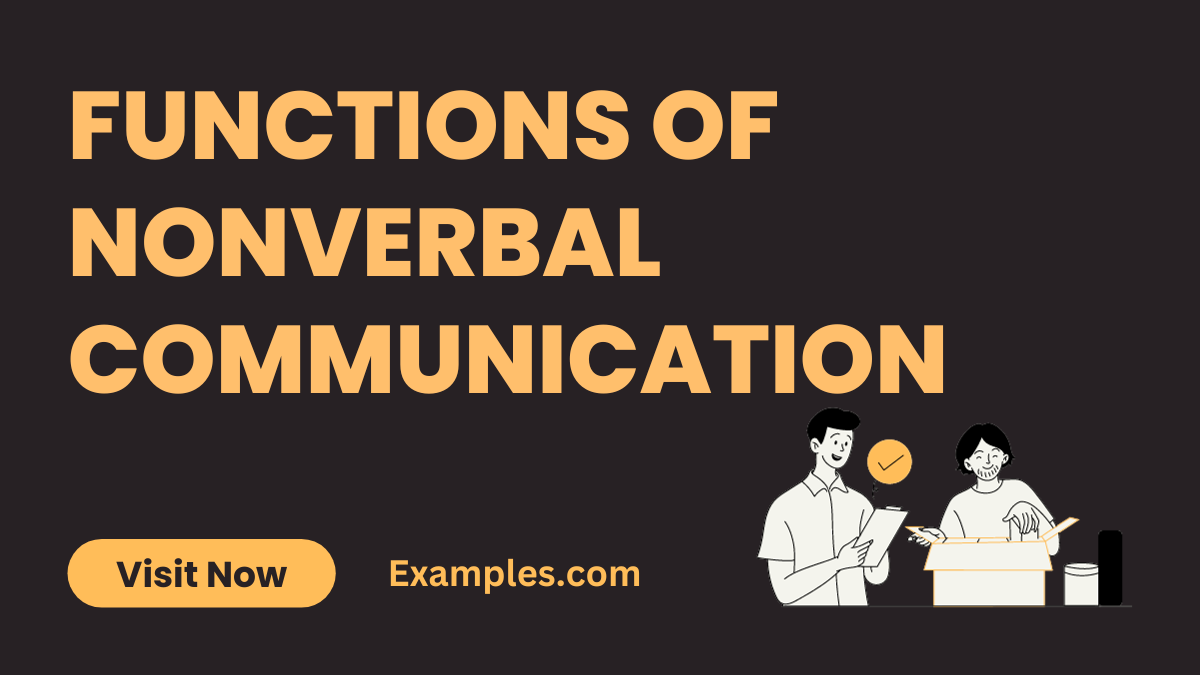Functions of Nonverbal Communication
Understanding the functions of nonverbal communication is essential in decoding the unspoken elements of human interaction. This form of communication, encompassing gestures, facial expressions, and body postures, plays a crucial role in conveying information beyond words. It aids in expressing emotions, reinforcing verbal messages, and indicating intentions subtly yet powerfully. This guide explores the multifaceted roles of nonverbal cues, underscoring their importance in effective communication across various contexts, from personal to professional settings.
Functions of Nonverbal Communication
Nonverbal communication plays a pivotal role in conveying messages and emotions without the use of words. It encompasses various aspects like facial expressions, body language, and gestures. Understanding these functions enhances interpersonal interactions and can significantly impact how messages are received and interpreted in everyday life, including in professional settings.

- Expressing Emotions:
Nonverbal communication plays a vital role in expressing emotions where words fall short. Facial expressions, like smiles or frowns, and body language, such as a slumped posture or crossed arms, vividly convey feelings of joy, anger, sadness, or comfort. These nonverbal cues are often instinctual and can communicate our emotional state more genuinely than verbal expressions, making them essential in understanding and empathizing with others in personal and professional interactions.
Example: A smile can indicate happiness, while a frown typically shows displeasure or concern. - Reinforcing Verbal Communication:
Nonverbal cues such as gestures, facial expressions, and tone of voice are crucial in reinforcing verbal communication. They add emphasis, clarify meaning, and offer insight into the speaker’s true intent and emotions. For instance, a nod along with a verbal agreement strengthens the affirmation. This synchronization of verbal and nonverbal communication enhances the clarity and effectiveness of the message, ensuring a more accurate and comprehensive understanding.
Example: Nodding while saying “yes” reinforces the affirmative message. - Conveying Interpersonal Attitudes:
Nonverbal communication is instrumental in conveying attitudes towards others, often more powerfully than words. Posture, proximity, eye contact, and facial expressions can subtly reveal one’s feelings and attitudes towards another person or situation. For example, leaning forward and maintaining eye contact during a conversation can indicate interest and positivity, while crossed arms might suggest disinterest or defensiveness, influencing interpersonal dynamics significantly.
Example: Leaning in during a conversation shows interest and engagement. - Facilitating Speech:
Facilitating speech through nonverbal communication involves using gestures and expressions to enhance or clarify spoken words. This function is crucial in enhancing understanding, especially in complex or detailed conversations. For example, hand gestures can help describe a concept’s size or shape, and facial expressions can add emphasis or emotion to the spoken word. This aspect of nonverbal communication is particularly useful in teaching, presentations, and when communicating across language barriers.
Example: Using hand gestures to describe the size or shape of an object. - Regulating Conversations:
Nonverbal cues play a vital role in regulating conversations by signaling when it’s appropriate for others to speak or respond. This function helps manage the flow of conversation and prevents misunderstandings. Examples include nodding to indicate understanding, making eye contact to invite response, or using hand gestures to signal someone else to take their turn in speaking. Effective use of these cues ensures smooth and respectful interactions in both personal and professional settings.
Example: Pausing and making eye contact can signal the other person to speak.

- Substituting for Verbal Communication:
In certain situations, nonverbal cues can completely substitute for verbal communication. This function is particularly important in scenarios where speaking is not possible or practical. Common examples include using a thumbs-up to indicate approval, a shake of the head for disagreement, or a wave as a greeting or farewell. These gestures provide a clear and concise way to convey messages without the need for words.
Example: A nod or shake of the head can substitute for a verbal “yes” or “no.” - Contradicting Verbal Messages:
Nonverbal communication can sometimes contradict verbal messages, revealing underlying emotions or attitudes that are not expressed verbally. This function is crucial in detecting insincerity or hidden feelings. For instance, someone may verbally agree to a plan while their crossed arms and tense posture suggest reluctance. Recognizing these discrepancies is key in understanding the true message being communicated.
Example: Saying “I’m fine” while showing a tense facial expression suggests otherwise. - Reflecting Cultural Differences:
Nonverbal communication can vary significantly across cultures, reflecting different norms and meanings. Understanding these cultural differences is essential in international communications to avoid misunderstandings. For example, the meaning of certain hand gestures, the appropriate distance to maintain during conversations, and the use of eye contact can differ vastly. Being aware of and sensitive to these differences is crucial for effective cross-cultural communication.
Example: The meaning of certain hand gestures can differ across cultures. - Creating Rapport:
Creating rapport through nonverbal communication involves using gestures, facial expressions, and body language that mirror or complement those of your conversational partner. This includes maintaining appropriate eye contact, mirroring body postures, and showing genuine interest through nods and smiles. Effective rapport building fosters a sense of connection and trust, facilitating smoother and more productive interactions both in personal and professional contexts.
Example: Adopting a similar posture or gesture as the other person during a conversation. - Implying Relational Messages:
Nonverbal cues play a significant role in implying relational messages, subtly conveying the nature and dynamics of relationships. The distance maintained during interactions (proxemics), touch (haptics), and the level of attention given all signal various aspects of relationships, such as intimacy, dominance, or formality. Understanding and appropriately using these cues can enhance relationship dynamics and communication effectiveness.
Example: Closer proximity often indicates a more intimate or comfortable relationship.

- Indicating Social and Economic Status:
Nonverbal communication often reflects an individual’s social and economic status. This includes aspects like physical appearance, clothing, accessories, and even the quality and brand of personal items. These nonverbal cues can create perceptions of wealth, authority, or professional standing, influencing how individuals are perceived and treated in social and professional environments.
Example: Wearing high-end clothing and accessories can indicate higher social status. - Signifying Personal Identity:
Nonverbal communication is a powerful tool in signifying personal identity. It encompasses elements like personal style, grooming, tattoos, and other forms of body art, which are forms of self-expression. These choices in appearance and behavior often reflect an individual’s values, beliefs, and unique personality traits, contributing to their personal and social identity.
Example: Unique hairstyles or tattoos can be a form of self-expression. - Conveying Professionalism:
Conveying professionalism nonverbally involves maintaining a demeanor and appearance that reflects respect, competence, and confidence in a business setting. This includes appropriate attire, a confident posture, controlled facial expressions, and a firm handshake. Effective use of these nonverbal cues can greatly enhance one’s professional presence and credibility in the workplace.
Example: A firm handshake often conveys confidence and professionalism. - Enhancing Persuasiveness:
Enhancing persuasiveness involves using communication effectively to convince others. This includes employing a combination of verbal eloquence, confident body language, and compelling storytelling to make your arguments more convincing. Successful persuaders understand their audience and tailor their messages accordingly, using facts, emotional appeals, and logical reasoning. Persuasiveness is crucial in various contexts, from business negotiations to public speaking, where convincing others is key to achieving desired outcomes.
Example: Maintaining steady eye contact when making a point can increase persuasiveness. - Detecting Deception:
Detecting deception in communication primarily involves observing inconsistencies between verbal and nonverbal cues. People who are deceptive often exhibit signs like avoiding eye contact, fidgeting, and displaying nervous gestures. It also involves listening for inconsistencies or improbabilities in what is being said. Developing this skill is valuable in professional settings such as law enforcement, psychology, and management, where discerning truthfulness is essential.
Example: Avoiding eye contact or fidgeting might suggest that someone is not telling the truth.

- Managing Impressions:
Managing impressions is the strategic control of information in social interactions to influence how one is perceived by others. It involves using nonverbal cues like attire, posture, and facial expressions, along with verbal communication, to project a desired image. In professional settings, impression management can help in career advancement, networking, and in establishing authority and credibility.
Example: Dressing formally for a job interview to create a good first impression. - Providing Feedback:
Providing feedback effectively is a critical communication skill, especially in educational, managerial, and personal development contexts. Effective feedback should be clear, constructive, and focused on behaviors rather than personal attributes. It should also be specific, actionable, and delivered in a manner that is sensitive to the recipient’s feelings. This skill is essential for fostering growth, learning, and improvement.
Example: A puzzled look can indicate confusion, prompting clarification. - Demonstrating Empathy and Sympathy:
Demonstrating empathy and sympathy involves understanding and sharing the feelings of another person. Empathy is conveyed through attentive listening, acknowledging others’ perspectives, and responding with compassion. Sympathy, while similar, often involves a more straightforward expression of concern. These skills are crucial in building strong personal and professional relationships, providing support, and in roles that require a high degree of interpersonal interaction.
Example: A gentle touch on the shoulder can convey sympathy. - Emphasizing Key Points in Speech:
Emphasizing key points in speech is a technique used to draw attention to the most important parts of a message. This can be achieved through various means such as changing the tone of voice, pausing for effect, using repetition, or employing body language and gestures. It’s an essential skill in public speaking, teaching, and any scenario where conveying clear and impactful messages is necessary.
Example: Raising a finger when stating an important fact. - Encouraging or Discouraging Interaction:
Encouraging or discouraging interaction involves using verbal and nonverbal cues to either invite or dissuade further communication. Open body language, nodding, and verbal affirmations can encourage interaction, signaling interest and willingness to engage. Conversely, closed body language, minimal eye contact, and brief responses can be used to subtly discourage continued interaction. This skill is useful in managing social dynamics in both personal and professional settings.
Example: Crossed arms and minimal eye contact can signal a desire to end the conversation.

- Setting the Tone of an Interaction:
Nonverbal communication is crucial in establishing the initial tone of an interaction. This can include facial expressions, posture, and initial gestures. For instance, a warm smile and relaxed posture can set a friendly and open tone, while a stern look and crossed arms may establish a more formal or serious ambiance. Understanding and using these cues effectively can create the desired atmosphere for communication.
Example: A warm, welcoming gesture can set a positive tone for a meeting. - Adapting to Context:
Adapting nonverbal communication to the context involves altering gestures, facial expressions, and posture based on the environment and situation. In professional settings, more formal nonverbal behavior is expected, while casual contexts allow for relaxed body language. The ability to switch between these modes as per the context is key to effective communication and maintaining appropriate relationships in diverse situations.
Example: Adopting a formal posture in a business meeting. - Conveying Urgency or Importance:
Nonverbal cues can effectively convey urgency or emphasize the importance of a message. Rapid hand movements, intense eye contact, and leaning forward can signal urgency or emphasize the importance of the topic at hand. These nonverbal signals can grab attention and underscore the criticality of the communication, prompting immediate response or action.
Example: Quick hand movements can indicate urgency in a situation. - Demonstrating Respect or Disrespect:
Nonverbal communication can be a powerful tool in showing respect or, conversely, disrespect. Respectful nonverbal cues include maintaining appropriate eye contact, nodding, and maintaining an open posture. Disrespectful nonverbal behaviors could involve eye-rolling, turning away, or checking a phone during conversation, all of which can significantly impact interpersonal dynamics.
Example: Not looking at someone while they are speaking can be perceived as disrespectful. - Indicating Agreement or Disagreement:
Nonverbal cues are often used to indicate agreement or disagreement without interrupting the speaker. Nodding can signify agreement and understanding, while shaking the head or frowning can nonverbally communicate disagreement or confusion. These cues provide feedback to the speaker without the need for verbal interruption, facilitating smoother communication flow.
Example: Nodding in agreement or shaking the head in disagreement.

- Establishing Dominance or Submission:
Body language can subtly communicate dominance or submission in an interaction. Dominant nonverbal behaviors might include taking up more space, using strong gestures, or maintaining a higher posture. Submissive cues might involve smaller gestures, lowered head, or avoiding direct eye contact. These cues can define the power dynamics in a conversation or relationship.
Example: Standing tall with hands on hips can signal dominance. - Guiding Conversational Flow:
Nonverbal cues are instrumental in guiding the flow of conversation. They can indicate when someone has finished speaking or wishes to say something. For example, pausing and making eye contact can invite others to speak, while looking away or stepping back might indicate that one has finished speaking or is disengaging from the conversation.
Example: Leaning forward and opening your hands can signal that you wish to add to the conversation. - Enhancing Storytelling:
In storytelling, nonverbal cues can add depth and emotion, making the story more engaging and relatable. Gestures, facial expressions, and changes in tone of voice can bring characters to life and add drama or humor to the narrative. Effective use of nonverbal communication in storytelling can captivate the audience and make the narrative more impactful.
Example: Changing facial expressions and gestures to reflect different characters or emotions in a story. - Conveying Sincerity and Trustworthiness:
Sincerity and trustworthiness can be communicated nonverbally through consistent eye contact, open gestures, and a congruent facial expression. These cues can build trust and credibility in both personal and professional interactions. Inconsistent nonverbal behavior, on the other hand, might raise doubts about the sincerity of the communicator.
Example: Consistent eye contact and open body language can convey sincerity and build trust. - Displaying Approachability and Openness:
Approachability and openness are conveyed through relaxed body posture, unguarded gestures, and a friendly facial expression. These nonverbal cues can make a person seem more accessible and willing to engage, fostering open and effective communication. In contrast, closed or guarded body language might deter others from initiating interaction.
Example: A relaxed stance and a smile can make someone appear more approachable.
Features of Nonverbal Communication
Nonverbal communication, a vital aspect of interaction, is characterized by several key features that enhance and often supersede verbal communication. Here’s a look at some of these essential features:
Universality and Variety
- Universal Application: Nonverbal cues are a global phenomenon, used across various cultures and languages, making them a universal aspect of human communication.
- Diverse Forms: It encompasses a wide range of forms including facial expressions, body language, gestures, and postures, each carrying distinct meanings.
Subtlety and Spontaneity
- Subtle yet Powerful: Nonverbal communication is often subtle but can convey powerful messages or emotions that words cannot.
- Spontaneous Expressions: Many nonverbal cues are spontaneous and involuntary, offering genuine insights into a person’s feelings or thoughts.
Context-Dependent and Culturally Influenced
- Contextual Meaning: The interpretation of nonverbal cues heavily relies on the context in which they occur, varying with the situation and relationship between communicators.
- Cultural Variability: Social and cultural norms significantly influence the use and interpretation of nonverbal cues, leading to variations in acceptability and meaning across different cultures.
Complementing and Contradicting Verbal Communication
- Reinforcing or Contradicting: Nonverbal cues can complement, reinforce, or even contradict verbal messages, adding depth and complexity to communication.
- Continuous Interaction: Even in the absence of speech, nonverbal communication continues, filling gaps in conversation and aiding in the flow of interaction.
Nonverbal communication is a key component in effective interpersonal interactions, offering insights beyond spoken words. Understanding and utilizing these silent cues—ranging from facial expressions to body language—enhances message clarity, emotional expression, and relationship building. This guide provides valuable insights into mastering nonverbal communication, an indispensable skill for personal and professional success in various communication contexts.



